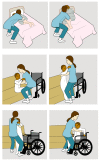A Review of Exoskeletons Considering Nurses
- PMID: 36146385
- PMCID: PMC9501849
- DOI: 10.3390/s22187035
A Review of Exoskeletons Considering Nurses
Abstract
Daily tasks of nurses include manual handling to assist patients. Repetitive manual handling leads to high risk of injuries due to the loads on nurses' bodies. Nurses, in hospitals and care homes, can benefit from the advances in exoskeleton technology assisting their manual handling tasks. There are already exoskeletons both in the market and in the research area made to assist physical workers to handle heavy loads. However, those exoskeletons are mostly designed for men, as most physical workers are men, whereas most nurses are women. In the case of nurses, they handle patients, a more delicate task than handling objects, and any such device used by nurses should easily be disinfected. In this study, the needs of nurses are examined, and a review of the state-of-the-art exoskeletons is conducted from the perspective of to what extent the existing technologies address the needs of nurses. Possible solutions and technologies and particularly the needs that have not been addressed by the existing technologies are discussed.
Keywords: care home; design; exoskeleton; healthcare; hospital; medical robotics; nurse; robotic assistance.
Conflict of interest statement
The authors declare no conflict of interest.
Figures






Similar articles
-
Exoskeleton technology in nursing practice: assessing effectiveness, usability, and impact on nurses' quality of work life, a narrative review.BMC Nurs. 2024 Mar 5;23(1):156. doi: 10.1186/s12912-024-01821-3. BMC Nurs. 2024. PMID: 38443892 Free PMC article. Review.
-
Exoskeleton Application to Military Manual Handling Tasks.Hum Factors. 2022 May;64(3):527-554. doi: 10.1177/0018720820957467. Epub 2020 Nov 18. Hum Factors. 2022. PMID: 33203237 Review.
-
The-state-of-the-art of soft robotics to assist mobility: a review of physiotherapist and patient identified limitations of current lower-limb exoskeletons and the potential soft-robotic solutions.J Neuroeng Rehabil. 2023 Jan 30;20(1):18. doi: 10.1186/s12984-022-01122-3. J Neuroeng Rehabil. 2023. PMID: 36717869 Free PMC article. Review.
-
A Passive Back-Support Exoskeleton for Manual Materials Handling: Reduction of Low Back Loading and Metabolic Effort during Repetitive Lifting.IISE Trans Occup Ergon Hum Factors. 2022 Jan-Mar;10(1):7-20. Epub 2021 Dec 2. IISE Trans Occup Ergon Hum Factors. 2022. PMID: 34763618
-
Exoskeletons in Nursing and Healthcare: A Bionic Future.Clin Nurs Res. 2021 Nov;30(8):1123-1126. doi: 10.1177/10547738211038365. Epub 2021 Aug 8. Clin Nurs Res. 2021. PMID: 34369180 Free PMC article.
Cited by
-
Smart Nursing Wheelchairs: A New Trend in Assisted Care and the Future of Multifunctional Integration.Biomimetics (Basel). 2024 Aug 14;9(8):492. doi: 10.3390/biomimetics9080492. Biomimetics (Basel). 2024. PMID: 39194471 Free PMC article. Review.
-
Evaluation of a passive back-support exoskeleton during in-bed patient handling tasks.Int J Occup Saf Ergon. 2024 Dec;30(4):1226-1233. doi: 10.1080/10803548.2024.2383077. Epub 2024 Aug 17. Int J Occup Saf Ergon. 2024. PMID: 39154219 Free PMC article.
-
Exoskeleton technology in nursing practice: assessing effectiveness, usability, and impact on nurses' quality of work life, a narrative review.BMC Nurs. 2024 Mar 5;23(1):156. doi: 10.1186/s12912-024-01821-3. BMC Nurs. 2024. PMID: 38443892 Free PMC article. Review.
-
Assessment of Exoskeletons on Nurses' Quality of Work Life: A Pilot Study at Foch Hospital.Nurs Rep. 2023 May 12;13(2):780-791. doi: 10.3390/nursrep13020068. Nurs Rep. 2023. PMID: 37218949 Free PMC article.
-
Improving research and development of wearable assistive and rehabilitation technologies: a systematic review on diversity factors.J Neuroeng Rehabil. 2025 Feb 21;22(1):31. doi: 10.1186/s12984-025-01562-7. J Neuroeng Rehabil. 2025. PMID: 39985039 Free PMC article.
References
-
- Spine Research Institute Even ‘Proper’ Technique Exposes Nurses’ Spines to Dangerous Forces. 2015. [(accessed on 13 August 2020)]. Available online: https://www.npr.org/2015/02/11/383564180/even-proper-technique-exposes-n....
Publication types
MeSH terms
LinkOut - more resources
Full Text Sources

